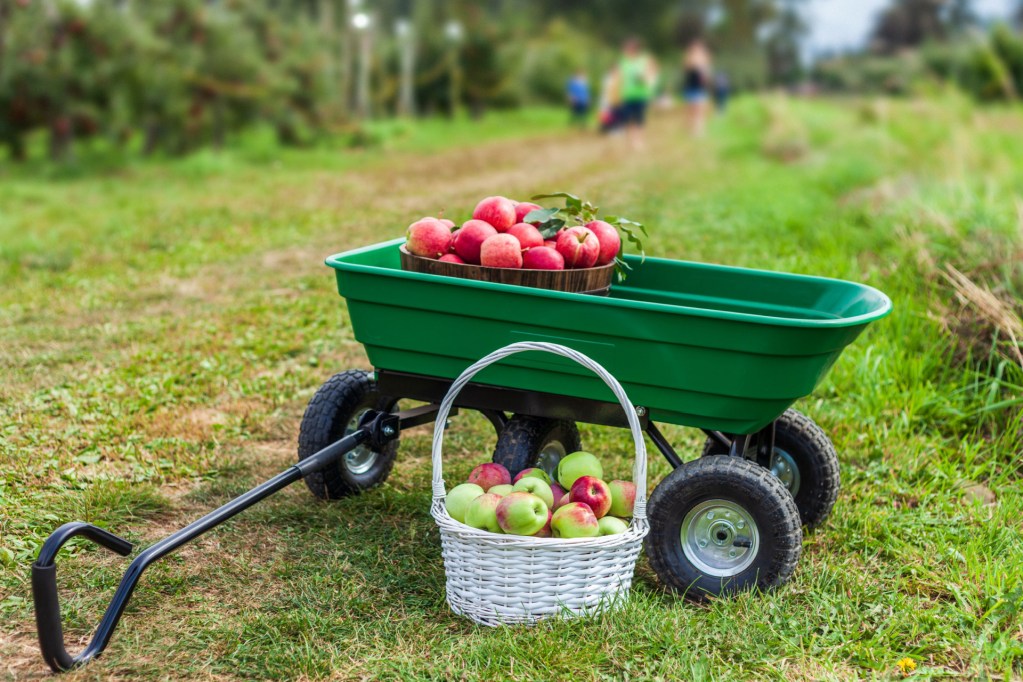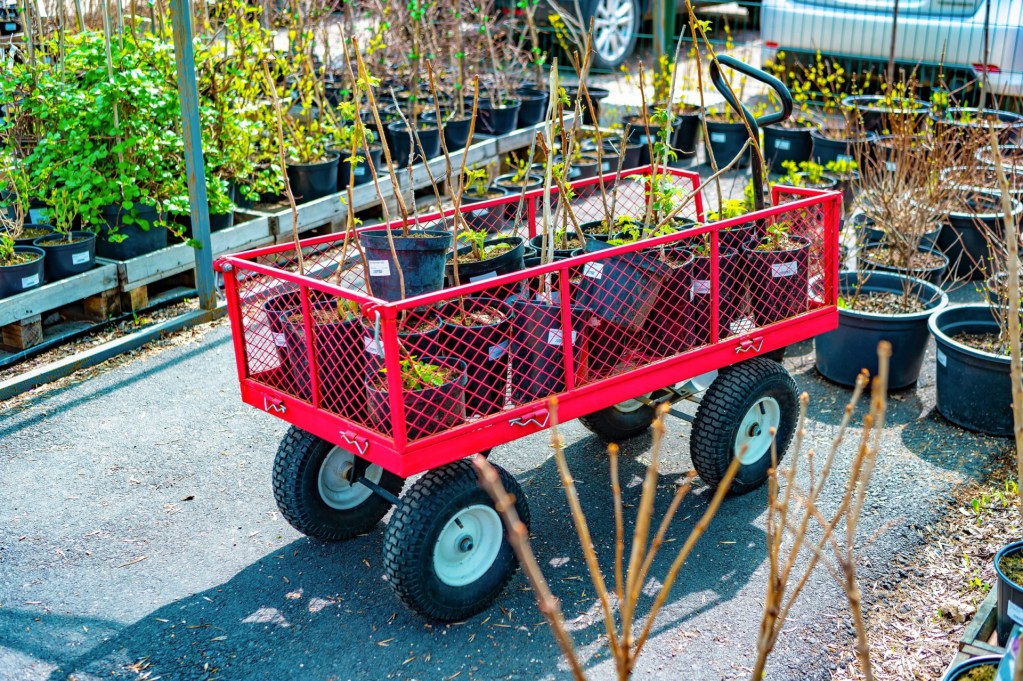
Gardening can become quite the workout as you pace back and forth to retrieve planting tools, toss away weeds, and unload soil. To make matters easier for yourself, invest in a garden cart. While you might need to set aside some money, your body will thank you for this initial investment, and you’ll be able to take your go-to gardening supplies with you as you work. If you’re in the market for a garden cart, here’s our cheat sheet on what to look for.
Why should you use a garden cart?
Gardening is seldom as easy as plopping down a plant in your garden. It’s a game of long-term maintenance that requires mulching, weeding, planting, and digging. While you’ll get your cardio in, it can get very tiring very quickly. A garden cart is a tool that’ll make your time in the garden so much easier and quicker when you need to get heavy items from point A to point B.
While a 4-inch flower pot might be no big deal to carry, a 50-pound bag of decorative landscape rocks is a different story. When you need to transport heavy tools and supplies — think shovels, soil, mulch, and pots — you’ll be grateful to have a garden cart by your side.

Garden cart features to consider
It’s tempting to head straight to your local hardware store and pick up a random garden cart, but keeping in mind specific details will help you choose the right one for your needs. When selecting a garden cart, here are the main factors you should note.
Material
Material is one of the most important features to weigh when you pick a garden cart. Generally speaking, garden carts are made of fabric, metal, or plastic. If you don’t have a lot of heavy-duty tasks in the yard, a cart made out of a thick, weather-resistant polyester material should be sufficient. For those who do work with heavy materials, a metal cart may make the most sense, although you want to look for some kind of powder-coated finish to avoid the hassle of rusting parts. It may also be worth looking into a cart with a plastic or poly bed to cut out worries about rusting altogether.
Weight capacity
Weight capacity is an important factor to consider when you’re picking out a cart for your garden. If you have a small patio garden, a fabric garden cart with a 50-pound capacity might be all you need for breezy tasks, such as weeding and deadheading. This simple design should be sufficient for carrying around not only dead foliage, but also medium-sized planters and small tools. On the flip side, if you’re regrading a gravel landscape or need to tote around bricks for edging, you’ll need a garden cart that can take on more weight. Some carts can take over 1,000 pounds, although you’ll likely need to connect this kind of large load to a tractor.
Foldability
Those who don’t need to carry around heavy items may be interested in a fabric garden cart that can fold down for easy storage. Other than convenient storage, there are foldable carts that make carrying your load easier. For example, some metal carts come with side panels that can fold down — this makes it easy to extend your cart bed’s surface area so that you can carry around large gardening tools and plants.
Handles
Handles make it easy for you to push and pull your cart around. Standard handles typically include a single pull-loop connected to a longer piece, but some feature a wide design that makes pushing easier. Many are made of metal and may come with grips for comfortable and ergonomic gardening. There are also handles that are adjustable, meaning you can keep them at just the height you need or fold them down. If you work with heavy materials, it’s worth looking into handles that you can remove or set aside so you can attach your wagon to a tractor or ATV.
Wheels
Without a trusty set of wheels, garden carts are essentially glorified shelves. When looking into cart wheels, you’ll typically see either flat-free or pneumatic tires. Flat-free tires are made with solid polyurethane foam, so you don’t need to worry about flat tires. However, they don’t handle heavy loads very well and tend to be more expensive. Pneumatic tires, on the other hand, roll smoothly and provide good traction. That said, you do need to keep an eye out for flats. When looking at garden cart models, check if you can get replacement tires in case your wheels break down.

Different types of garden carts
There is a great range of garden cart types out there. Here are a few of the most common types and what you might use them for. Remember to pick one for your personal needs instead of opting for one with the flashiest specs!
Loading large plants and produce: Utility cart
From time to time, you may need to move large container plants and freshly harvested produce around in the garden. A utility cart with mesh side panels can help get the job done. If you find you need more surface area, many utility carts can also convert into flatbed carts so long items don’t jostle out.
Transporting heavy items: Dump cart
Whether you need to unload gravel, mulch, or soil, a heavy-duty dump cart (such as the ones from the brand Gorilla) can come in handy. Your typical dump cart usually features a sturdy poly bed that can handle 500 to 1,200 pounds. Because they’re designed to carry heavy loads, many dump carts can also easily attach to tractors or ATVs.
Manually pushing loads: Wheelbarrow
One advantage of a wheelbarrow is that it’s easy to push — wheelbarrows are usually designed with two ergonomic handles, one to two wheels, and a sloped tray. If your gardening materials aren’t heavy enough to warrant a tractor, a wheelbarrow can be a very comfortable tool to maneuver.
Initiating small garden projects: Collapsible cart
If you just need to gather faded blooms and weeds in the garden, a foldable fabric cart with a 50- to 100-pound weight capacity can be a convenient option. You can also use one to tote around essentials, such as shovels, trowels, and planters when you’re doing yard work.
Gardening can be a lot of hard work, and there are times when your supplies are too heavy to carry. With a convenient gardening cart, you’ll be able to get more work done while reducing physical strain on your body. For a fun and efficient time in the yard, a garden cart will be well worth the investment.



